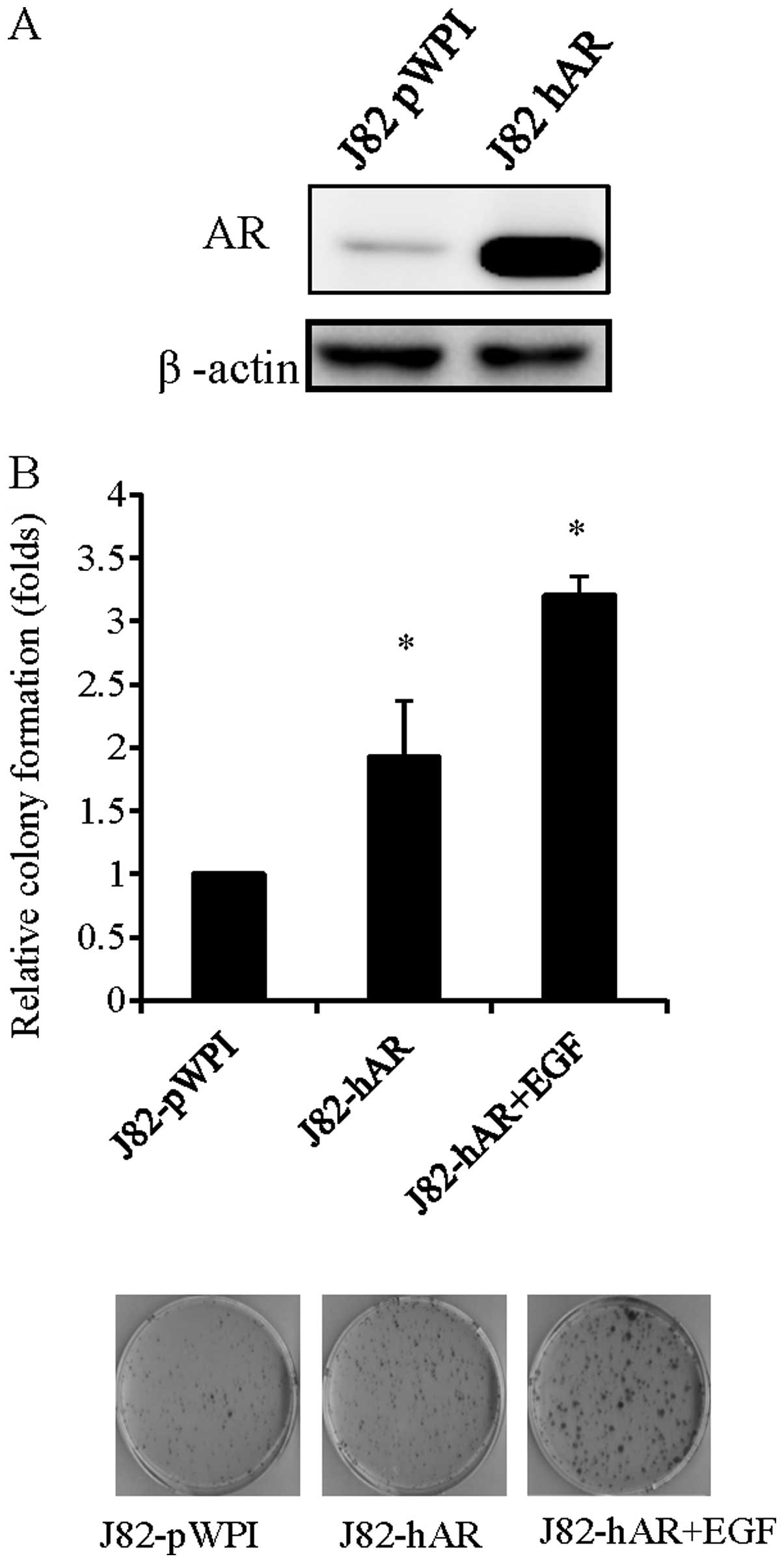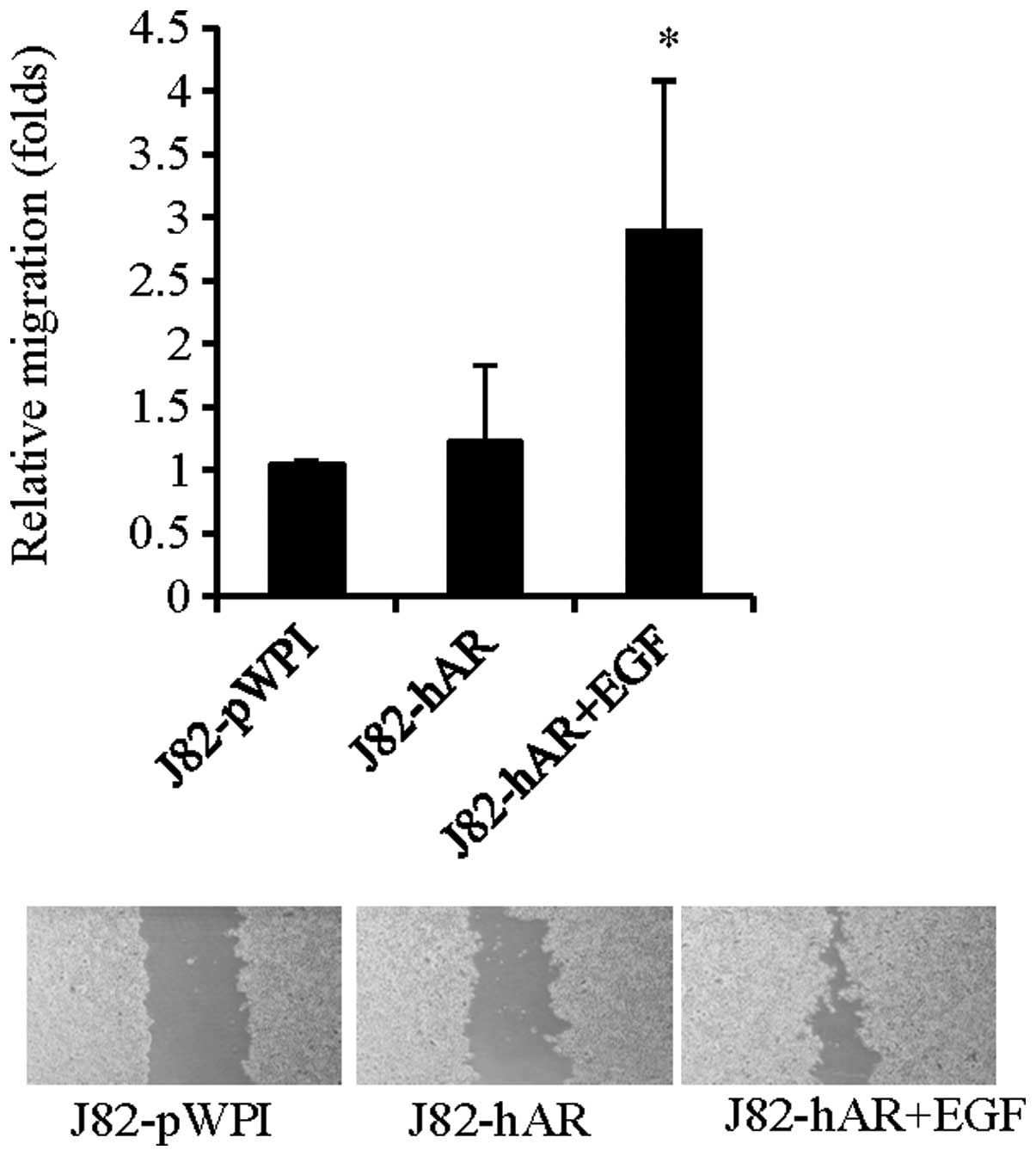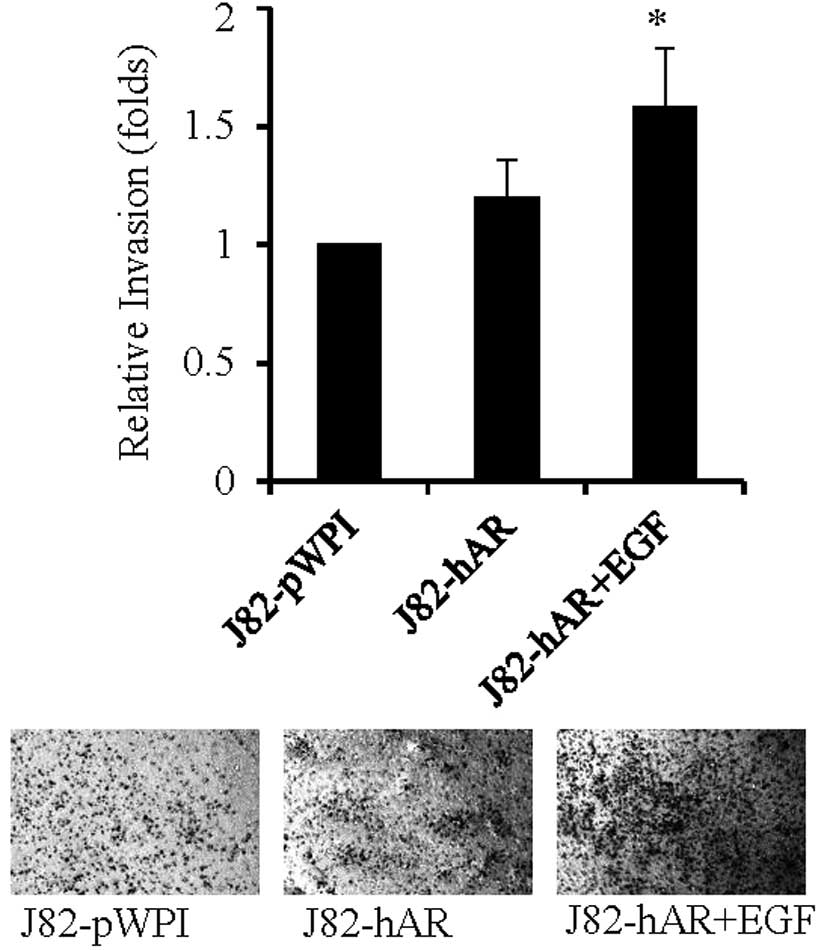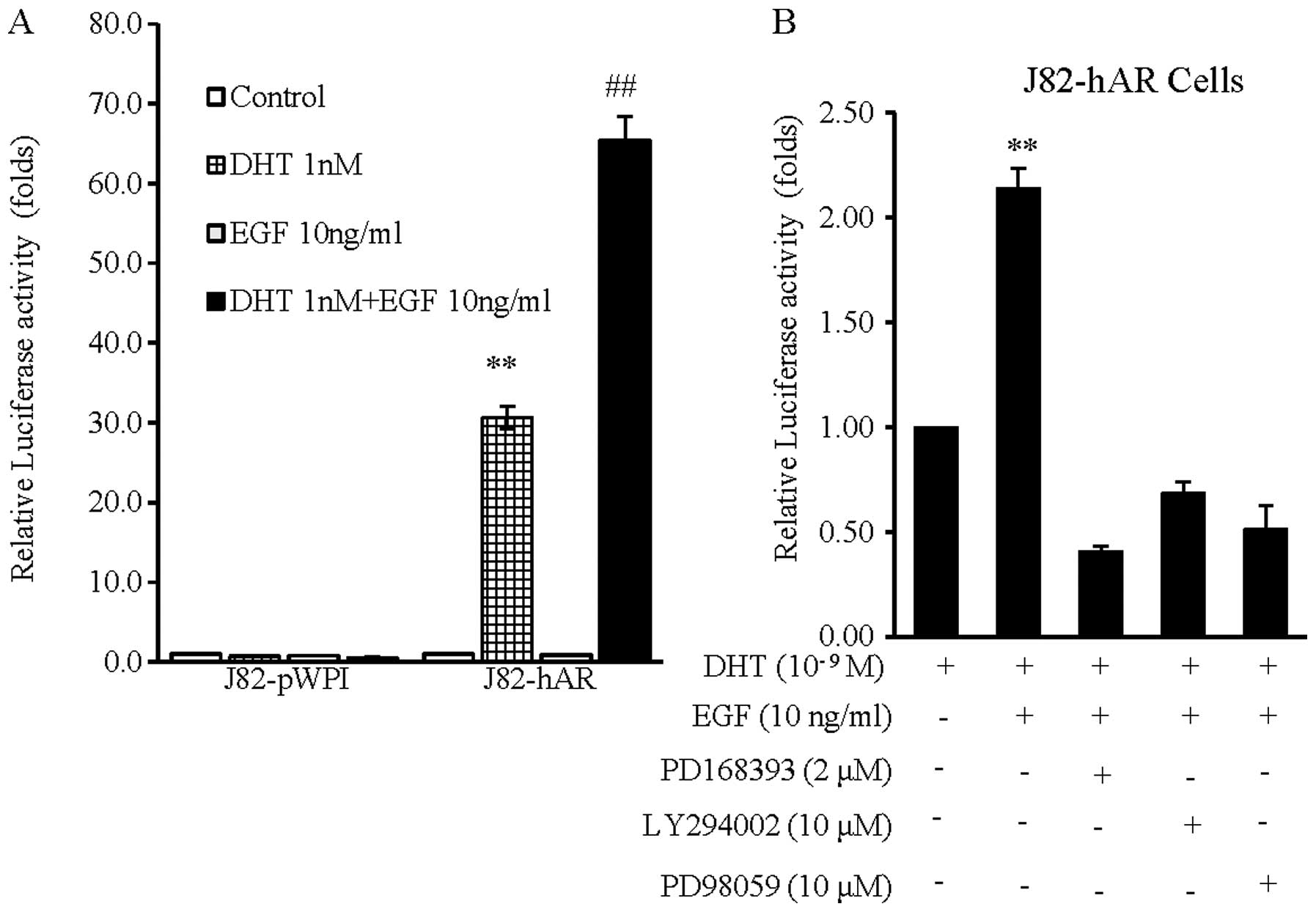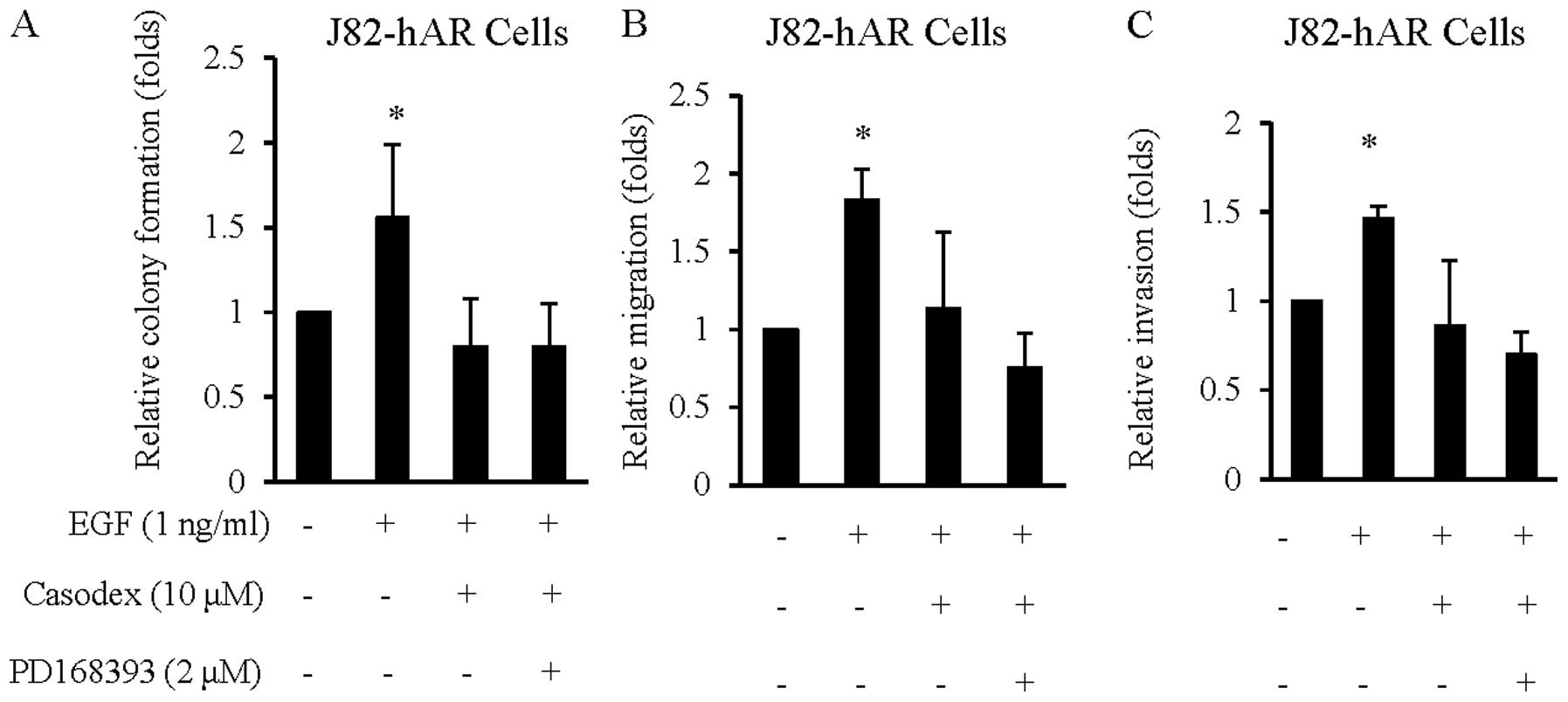Epidermal growth factor enhances androgen receptor‑mediated bladder cancer progression and invasion via potentiation of AR transactivation
- Authors:
- Published online on: October 10, 2013 https://doi.org/10.3892/or.2013.2792
- Pages: 2917-2922
Abstract
Introduction
Bladder cancer (BCa) ranks sixth in cancer incidence in the United States, and it is the fourth most common cancer in men with a male dominance (male to female ratio 4:1) (1). In 2011, there were 10,670 estimated male deaths from BCa and it was the eighth cause of cancer-related mortality among males (1). Therefore, males are more susceptible to BCa than females. It is proposed that the gender difference in BCa is linked to sex hormones and their receptors (2,3). However, the exact mechanism of how sex hormone receptor(s) affect BCa development and progression remains unclear. Miyamoto et al(4) demonstrated the possible involvement of androgens and androgen receptor (AR) in BCa development. Using the carcinogen of N-butyl-N-(4-hydroxybutyl)nitrosamine (BBN) to induce BCa in wild-type male and female mice, Miyamoto et al(4) found male mice lacking AR (ARKO) (with little androgen and deleted AR) failed to develop BCa, yet almost all wild-type male mice developed BCa, suggesting AR might play key roles during BCa development. The study also found 50% of BBN treated castrated mice (with little androgen yet existence of AR) still developed BCa, indicating AR in these castrated mice might still be able to promote BCa development, indicating that other factor(s) could affect AR activity and facilitate the development of BCa at the castration level of androgens (4). Other reports also indicated that in a BBN-induced rat model, surgical or medical castration could only reduce (and not completely eliminate) the number of rats with BCa (5).
AR is a transcriptional factor that may need androgens to transactivate its target genes via direct binding on androgen response element (ARE). Accumulating evidence indicates AR could also be transactivated via rapid non-androgen intracellular signals, including c-Src, the downstream MAPK signals, G-protein coupled receptor and downstream calcium signals (6). However, almost all these non-androgens-induced AR transactivations were found in in vitro cell lines without strong in vivo evidence. The indication that non-androgens could induce BCa development via transactivation of AR might therefore represent promising in vivo evidence that warrants further characterization.
Among several potential candidates, we first decided to assay the EGF, which is excreted in high concentrations in the urine and stimulates urothelial cell growth, and acts through EGFR to promote the development of various types of cancer, including urothelial tumors (7). EGF was shown to increase BCa cell growth and invasion activity (8,9). EGFR belongs to the human epidermal receptor (HER) family of receptor tyrosine kinases that contains 4 receptors; HER1 (EGFR, erb-B1), HER2 (neu, erb-B2), HER3 (erb-B3), HER4 (erb-B4) and is a 170-kDa membrane-spanning glycoprotein with an extracellular ligand-binding domain, a transmembrane domain and an intracellular cytoplasmic domain with tyrosine kinase activity (10). The overexpression of EGFR has been linked to several malignant features and prognosis in superficial BCa (11), tumor proliferation (12) and the development of secondary recurrences (13).
In prostate cancer cells, EGF was shown to transactivate AR via signaling involving the MAPK to TIF2/GRIP1 (14). Therefore, we hypothesized that EGF might be able to potentiate AR transcriptional activity that may enhance BCa development.
Materials and methods
Cell culture and chemicals
Human urothelial carcinoma cell line J82, and human embryonic kidney cell line 293T (all obtained from the American Type Culture Collection, Manassas, VA, USA) were maintained in appropriate medium (DMEM for 293T and MEM for J82) supplemented with 10% fetal bovine serum (FBS) at 37°C in a humidified atmosphere of 5% CO2. Cells were cultured in phenol red-free medium supplemented with 5% charcoal-stripped FBS at least 18 h before experimental treatment. We purchased dihydrotestosterone (DHT) and EGF from Sigma. Casodex (anti-androgen), LY 294002 and PD168393 were purchased from Enzo Life Sciences (Farmingdale, NY, USA). PD98059 was purchased from Gibco (Frederick, MD, USA).
Luciferase reporter gene assay
Bladder cancer cells at a density of 50–60% confluence in 24-well plates were co-transfected with 250 ng of ARE-luc reporter plasmid DNA and 2.5 ng of PRL-TK-luc plasmid DNA, using Lipofectamine 2000 (Invitrogen, Carlsbad, CA, USA). After 24 h of transfection, the cells were treated with EGF in the presence or absence of ligands (DHT) for 24 h. Cells were then harvested, lysed and assayed for luciferase activity, which was determined using a Dual-Luciferase Reporter Assay kit (Promega, Madison, WI, USA) and luminometer (TD-20/20; Turner Biosystems, Sunnyvale, CA, USA).
AR lentiviral cDNA overexpression
To establish AR overexpression cells, we used lentiviral vectors containing AR cDNA (15). In brief, a full-length wild-type human AR cDNA was subcloned into pWPI plasmid (Addgene, Cambridge, MA, USA), and the lentivirus-based vector (pWPI-AR/pWPI-control) with pMD2.G packaging and psPAX2 envelope plasmids (lentivirus:packaging:envelope=2:1:1) was co-transfected into 293T cells, using lipofectamine reagent. After 48 h of transfection, the target cells (J82) were cultured in the presence of viral supernatant containing 8 μg/ml polybrene (Millipore, Billerica, MA, USA) for 6 h. Flow cytometry was used to evaluate the population of cells overexpressing AR (J82-hAR) or vector only (J82-pWPI).
Colony formation assay
For colony formation assay, 103 cells were subcultured into 60-mm tissue culture dishes and incubated for 10–14 days with designated treatments, with Charcoal/Dextran treated fetal bovine serum (CD FBS) medium and the medium was changed at days 4 and 8. Cells were then washed twice with PBS and stained with 0.1% crystal violet for 15 min before counting under a light microscope. Clusters of at least 50 cells were counted as colonies.
Wound healing migration assay
Cells were seeded onto a 12-well tissue culture plate and were grown to confluence. Cell monolayers were then wounded by sterile pipette tips (200 μl) that generated a gap. Wounded monolayers were then washed 3 times with PBS to remove cell debris and incubated in 10% CD FBS medium with designated treatments for 24 h to allow cells to migrate. Images of cells were then captured using a microscope equipped with a camera. The relative migration folds were determined by the area covered by migrating cells of test cells in the wounded area compared to that of control cells, analyzed with NIS-Elements BR (Nikon) software.
Transwell invasion assay
Cell invasion through a three-dimensional extracellular matrix was assessed by a Matrigel invasion assay using BD Matrigel coated-Transwell with 8.0 μm filter membranes. Cells resuspended in 200 μl of serum free medium were plated onto each filter with designated treatments, and 750 μl of DMEM containing 10% CD FBS was added into the lower compartment of invasion chambers. The cells in the top well with invasive capacity could migrate through the Matrigel layer and 8.0 μm pores. After 24 h, filters were washed in 4% paraformaldehyde and stained with 1% crystal violet. Cells on the upper surface of the filters were removed with cotton swabs. Cells that had invaded to the lower surface of the filter were counted under the microscope.
Statistical analysis
All experimental data are reported as means ± SD (standard error). Statistical analysis was performed by t-test. A P-value of <0.05 was considered to indicate a statistically significant result.
Results
EGF increases AR-mediated BCa cell growth
To examine if EGF can function through AR to influence BCa progression, we first performed the colony formation assay to investigate the effects of EGF on BCa cell growth with or without the addition of AR. Therefore, we added AR in J82 cells by lentiviral infection and confirmed the addition by western blot analysis (Fig. 1A). The addition of AR in J82 cells increased colony formation number as compared to the cells infected with virus carrying parent expression vector (J82-pWPI) (Fig. 1B). Notably, addition of EGF in J82-hAR cells further enhanced BCa cell growth, suggesting that EGF could function through AR to affect BCa cell growth.
EGF increases AR-mediated BCa cell migration
To further investigate if EGF could also influence BCa cell migration via modulation of AR function, we then performed wound healing migration assay to investigate the effects of EGF on BCa cell migration. As shown in Fig. 2, addition of EGF in J82-hAR cells increased cell migration, suggesting that EGF could also enhance BCa cell migration via modulation of AR function.
EGF increases AR-mediated BCa cell invasion
To further investigate if EGF could also influence BCa cell invasion via modulation of AR function, we then performed Transwell invasion assay to investigate the effects of EGF on BCa cell invasion. As shown in Fig. 3, addition of EGF in J82-hAR cells increased the number of cells invading through Matrigel-coated Transwell filters, suggesting that EGF could also enhance BCa cell invasion via modulation of AR function.
EGF potentiates AR transcriptional activity
We then investigated the potential mechanism of how EGF could function through AR signaling to enhance BCa cell growth, migration and invasion. Using the luciferase reporter assays with androgen-inducible promoter with four AREs in BCa J82 cells, we first proved addition of the very low concentration of 1 nM DHT (which is the DHT concentration in prostate after patients received androgen deprivation therapy with surgical/chemical castration) could still induce AR transcriptional activity in J82-hAR cells, and not in J82-pWPI cells (Fig. 4A). Notably, addition of EGF (10 ng/ml) alone in J82-hAR cells induced little AR transcriptional activity, but addition of EGF (10 ng/ml) and 1 nM DHT led to significantly further enhanced AR transcriptional activity (Fig. 4A and B), suggesting EGF was able to enhance AR transcriptional activity in the presence of the castration level of DHT.
To elucidate the mechanism of how EGF could enhance AR transactivation, we assessed the effects of PD168393 (a specific EGFR inhibitor), LY294002 [a potent inhibitor of phosphoinositide 3-kinases (PI3Ks)] and PD98059 (a potent and selective inhibitor of MEK kinase) on EGF-enhanced AR transactivation in BCa AR-positive J82-hAR cells. The results showed that EGF-induced AR transcriptional activity (Fig. 4B, lane 2 vs. 1) was suppressed significantly by PD168393 (Fig. 4B, lane 3 vs. 2), Ly294002 (Fig. 4B, lane 4 vs. 2) and PD98059 (Fig. 4B, lane 5 vs. 2). These results suggest that EGF enhances AR transactivation through the modulation of EGFR and PI3K or MAPK/ERK signaling pathways.
Targeting AR blocks the effect of EGF in BCa cell growth, migration and invasion
Results from Figs. 1–4 suggest that EGF could enhance AR transcriptional activity at the castration level of androgen that resulted in increasing BCa cell growth, migration and invasion. We then examined if anti-androgen could alter these EGF effects on BCa cell growth, migration and invasion. As shown in Fig. 5, addition of the anti-androgen, Casodex suppressed EGF effects on BCa cell growth (Fig. 5A), migration (Fig. 5B) and invasion (Fig. 5C). The increased suppression effects by EGFR inhibitor of PD168393 on AR function after addition of Casodex (Fig. 5A–C) further suggested AR might play a key role in the effects of EGF on BCa progression and metastasis.
Discussion
In the present study, we showed that EGF could act through AR to further promote BCa progression by increasing cell growth, migration and invasion. Overexpression of EGFR in urothelial tumors may be associated with cancer progression (16,17). Zheng et al(18) demonstrated that androgen could enhance EGFR expression that might then lead to activation of AKT and ERK. Similar results were also found in prostate cancer showing that androgen could promote EGFR expression (19). In addition, Migliaccio et al(20) also revealed that AR might play an essential role in activating EGFR signaling in the AR-positive prostate cancer LNCaP cells. Finally, Craft et al(21) reported that EGFR signal could amplify AR signaling to facilitate prostate cancer relapse following hormone therapy. Taken together, these reports suggest that a positive regulation loop exists between AR and EGFR in either prostate cancer or BCa.
The interaction between EGF and AR in BCa has not been well investigated, but in prostate cancer, this interaction has been documented in a number of studies (22). EGF in prostatic tissue has a mitogenic role in the prostate gland (23). Compared to other growth factors, such as IGF-I and KGF, EGF has fewer effects on the transcriptional activity of the androgen-responsive reporter gene when compared to IGF-I and KGF in prostate cancer cells (14). Further studies indicated that EGF induced activation of the MAPK pathway and the interaction with the PKA pathway to regulate proliferation of prostate cancer cells (24,25). In addition, EGF was demonstrated to induce DNA synthesis, cytoskeletal changes and Src activation in LNCaP cells through triggering rapid association of Src with AR and ERb in LNCaP cells, suggesting AR played a key role in EGF signaling by forming a complex with Src to induce EGFR tyrosine phosphorylation (20). Furthermore, EGF signaling can act through MAPK to increase TIF2/GRIP1 coactivation of AR transactivation in recurrent prostate cancer (26). EGF requires the presence of androgen to initiate the nuclear translocation of AR induced ligand-independent transcriptional activity suggesting EGF causes an over-activated AR (27). In the present study, we further proved the cross-talk between AR and EGF signaling pathways, which may have significant implications for the understanding of BCa development and progression.
Our previous in vivo studies (4,18) and our present in vitro study provided important finding that EGF may function through AR signals to influence the BCa cell growth, migration and invasion. However, there may be a reciprocal positive regulation between these two key factors as well. From our results, we propose a possible molecular mechanism to delineate how EGF affects BCa progression via AR, by which EGF binds to EGFR to activate ERK and AKT to act on its downstream effectors and potentiate AR effects on BCa progression. The implication of this finding is that we identified the link between EGF and AR signals. EGFR inhibitors were proposed to treat urothelial cancer, but in vitro data using BCa cell lines showed that some cells failed to have such antiproliferative effect of EGFR inhibitors, suggesting cells survive from molecular target agent attack by activating downstream signals (28). The clinical trials of molecular targeting agents, including EGFR antagonist, have been applied in transitional urothelial carcinoma and muscular invaded BCa. There is currently no effective EGFR antagonist single administration for urothelial cancer trials. However, increasingly more combinational therapy trials including EGFR antagonists are ongoing in phase II trials with urothelial cancer patients. Therefore, combinational therapies targeting EGFR and AR may provide a better therapeutic strategy to suppress BCa progression. We previously tested the combinational therapy by targeting AR and other factors in liver cancer therapy (15,29,30). The data in the present study may provide a novel therapeutic strategy of combining targeting EGFR and AR in urothelial cancer therapy.
Acknowledgements
The present study was supported by the NIH grant (CA155477), China Medical University grants (CMU99-N2-06-2 and CMU DMR-100-166), the Buddhist Tzu Chi General Hospital grant (TTCRD 101-10), the National Science Council grant (NSC 101-2314-B-027-MY3), and the Taiwan Department of Health Clinical Trial and Research Center of Excellence grant DOH99-TD-B-111-004.
References
|
Siegel R, Ward E, Brawley O and Jemal A: Cancer statistics, 2011: the impact of eliminating socioeconomic and racial disparities on premature cancer deaths. CA Cancer J Clin. 61:212–236. 2011. View Article : Google Scholar : PubMed/NCBI | |
|
Shariat SF, Sfakianos JP, Droller MJ, Karakiewicz PI, Meryn S and Bochner BH: The effect of age and gender on bladder cancer: a critical review of the literature. BJU Int. 105:300–308. 2010. View Article : Google Scholar : PubMed/NCBI | |
|
Fajkovic H, Halpern JA, Cha EK, et al: Impact of gender on bladder cancer incidence, staging, and prognosis. World J Urol. 29:457–463. 2011. View Article : Google Scholar : PubMed/NCBI | |
|
Miyamoto H, Yang Z, Chen YT, et al: Promotion of bladder cancer development and progression by androgen receptor signals. J Natl Cancer Inst. 99:558–568. 2007. View Article : Google Scholar : PubMed/NCBI | |
|
Imada S, Akaza H, Ami Y, Koiso K, Ideyama Y and Takenaka T: Promoting effects and mechanisms of action of androgen in bladder carcinogenesis in male rats. Eur Urol. 31:360–364. 1997.PubMed/NCBI | |
|
Heinlein CA and Chang C: The roles of androgen receptors and androgen-binding proteins in nongenomic androgen actions. Mol Endocrinol. 16:2181–2187. 2002. View Article : Google Scholar : PubMed/NCBI | |
|
Grivas PD, Day M and Hussain M: Urothelial carcinomas: a focus on human epidermal receptors signaling. Am J Transl Res. 3:362–373. 2011.PubMed/NCBI | |
|
Kanno N, Nonomura N, Miki T, et al: Effects of epidermal growth factor on the invasion activity of the bladder cancer cell line. J Urol. 159:586–590. 1998. View Article : Google Scholar | |
|
Kawamata H, Azuma M, Kameyama S, Nan L and Oyasu R: Effect of epidermal growth factor/transforming growth factor alpha and transforming growth factor beta 1 on growth in vitro of rat urinary bladder carcinoma cells. Cell Growth Differ. 3:819–825. 1992.PubMed/NCBI | |
|
Rowinsky EK: The erbB family: targets for therapeutic development against cancer and therapeutic strategies using monoclonal antibodies and tyrosine kinase inhibitors. Annu Rev Med. 55:433–457. 2004. View Article : Google Scholar | |
|
Lipponen P and Eskelinen M: Expression of epidermal growth factor receptor in bladder cancer as related to established prognostic factors, oncoprotein (c-erbB-2, p53) expression and long-term prognosis. Br J Cancer. 69:1120–1125. 1994. View Article : Google Scholar : PubMed/NCBI | |
|
Sauter G, Haley J, Chew K, et al: Epidermal-growth-factor-receptor expression is associated with rapid tumor proliferation in bladder cancer. Int J Cancer. 57:508–514. 1994. View Article : Google Scholar : PubMed/NCBI | |
|
Chow NH, Chan SH, Tzai TS, Ho CL and Liu HS: Expression profiles of ErbB family receptors and prognosis in primary transitional cell carcinoma of the urinary bladder. Clin Cancer Res. 7:1957–1962. 2001.PubMed/NCBI | |
|
Culig Z, Hobisch A, Cronauer MV, et al: Androgen receptor activation in prostatic tumor cell lines by insulin-like growth factor-I, keratinocyte growth factor, and epidermal growth factor. Cancer Res. 54:5474–5478. 1994. | |
|
Ma WL, Hsu CL, Yeh CC, et al: Hepatic androgen receptor suppresses hepatocellular carcinoma metastasis through modulation of cell migration and anoikis. Hepatology. 56:176–185. 2012. View Article : Google Scholar : PubMed/NCBI | |
|
Nguyen PL, Swanson PE, Jaszcz W, et al: Expression of epidermal growth factor receptor in invasive transitional cell carcinoma of the urinary bladder. A multivariate survival analysis. Am J Clin Pathol. 101:166–176. 1994.PubMed/NCBI | |
|
Chow NH, Tzai TS, Lin SN, Chan SH and Tang MJ: Reappraisal of the biological role of epidermal growth factor receptor in transitional cell carcinoma. Eur Urol. 24:140–143. 1993.PubMed/NCBI | |
|
Zheng Y, Izumi K, Yao JL and Miyamoto H: Dihydrotestosterone upregulates the expression of epidermal growth factor receptor and ERBB2 in androgen receptor-positive bladder cancer cells. Endocr Relat Cancer. 18:451–464. 2011. View Article : Google Scholar : PubMed/NCBI | |
|
Brass AL, Barnard J, Patai BL, Salvi D and Rukstalis DB: Androgen up-regulates epidermal growth factor receptor expression and binding affinity in PC3 cell lines expressing the human androgen receptor. Cancer Res. 55:3197–3203. 1995.PubMed/NCBI | |
|
Migliaccio A, Di Domenico M, Castoria G, et al: Steroid receptor regulation of epidermal growth factor signaling through Src in breast and prostate cancer cells: steroid antagonist action. Cancer Res. 65:10585–10593. 2005. View Article : Google Scholar | |
|
Craft N, Shostak Y, Carey M and Sawyers CL: A mechanism for hormone-independent prostate cancer through modulation of androgen receptor signaling by the HER-2/neu tyrosine kinase. Nat Med. 5:280–285. 1999. View Article : Google Scholar : PubMed/NCBI | |
|
Culig Z, Hobisch A, Cronauer MV, et al: Regulation of prostatic growth and function by peptide growth factors. Prostate. 28:392–405. 1996. View Article : Google Scholar : PubMed/NCBI | |
|
Heinlein CA and Chang C: Androgen receptor in prostate cancer. Endocr Rev. 25:276–308. 2004. View Article : Google Scholar : PubMed/NCBI | |
|
Putz T, Culig Z, Eder IE, et al: Epidermal growth factor (EGF) receptor blockade inhibits the action of EGF, insulin-like growth factor I, and a protein kinase A activator on the mitogen-activated protein kinase pathway in prostate cancer cell lines. Cancer Res. 59:227–233. 1999. | |
|
Chen T, Cho RW, Stork PJ and Weber MJ: Elevation of cyclic adenosine 3′,5′-monophosphate potentiates activation of mitogen-activated protein kinase by growth factors in LNCaP prostate cancer cells. Cancer Res. 59:213–218. 1999. | |
|
Gregory CW, Fei X, Ponguta LA, et al: Epidermal growth factor increases coactivation of the androgen receptor in recurrent prostate cancer. J Biol Chem. 279:7119–7130. 2004. View Article : Google Scholar : PubMed/NCBI | |
|
Orio F, Terouanne B, Georget V, et al: Potential action of IGF-1 and EGF on androgen receptor nuclear transfer and transactivation in normal and cancer human prostate cell lines. Mol Cell Endocrinol. 198:105–114. 2002. View Article : Google Scholar : PubMed/NCBI | |
|
Kassouf W, Dinney CPN, Brown G, et al: Uncoupling between epidermal growth factor receptor and downstream signals defines resistance to the antiproliferative effect of Gefitinib in bladder cancer cells. Cancer Res. 65:10524–10535. 2005. View Article : Google Scholar | |
|
Ma WL, Hsu CL, Wu MH, et al: Androgen receptor is a new potential therapeutic target for the treatment of hepatocellular carcinoma. Gastroenterology. 135:947–955. 955.e1–5. 2008.PubMed/NCBI | |
|
Wu JT, Han BM, Yu SQ, Wang HP and Xia SJ: Androgen receptor is a potential therapeutic target for bladder cancer. Urology. 75:820–827. 2010. View Article : Google Scholar : PubMed/NCBI |



